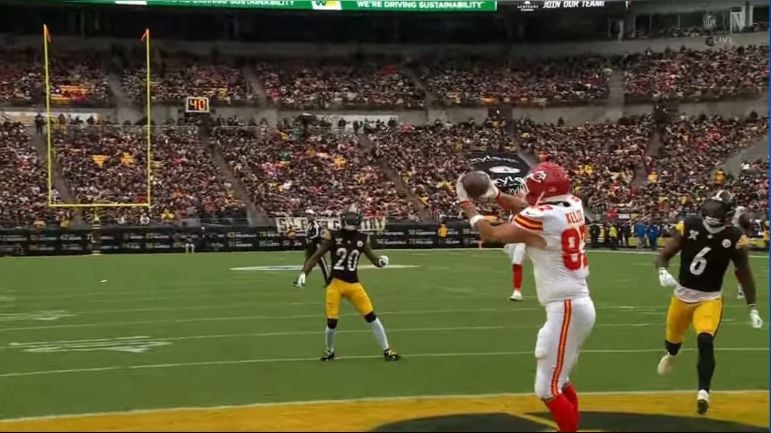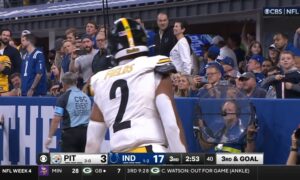Having had the weekend to digest the Pittsburgh Steelers’ biggest defensive problem, miscommunication, I’m collecting my thoughts to try and figure out why the defense is struggling so much. Up front, determining these things is difficult. Figuring out what and who went wrong on a coverage bust is tough to do from the outside without knowing the playbook, checks, signals, etc. It’s much easier to explain things when it all goes well.
And admittedly, topics like these are in literal search of answers, trying to make sense of messy and broken plays. But after studying the main coverage busts and big gains/touchdowns the Steelers have allowed the last two weeks against the Baltimore Ravens and Kansas City Chiefs. I’ve boiled it down to three umbrella problems.
1. Message Communicated, Not Always Received
2. Hurt By Speed
3. Struggling With Motion, 3×1 Formations
I’ll talk through each big completion allowed off busted coverage below.
Isaiah Likely’s Touchdown
Against Baltimore Week 16. A 3×1 formation with an unbalanced look, LT Ronnie Stanley flipping over from left to right tackle. Likely aligns as No. 3 but runs a wheel route to become the new No. 1. Pittsburgh struggles to pick it up, FS Minkah Fitzpatrick is frozen by the toss action in the flat while LB Patrick Queen gets picked by the seam route, and it’s a pitch and catch for the score.
The first example of Pittsburgh struggling against 3×1. I can’t tell you exactly who this is on, Queen or Fitzpatrick, but the Steelers didn’t handle this well.
Mark Andrews’ Touchdown
Later in the Ravens game. Baltimore initially aligns 2×2 but motions WR Zay Flowers from left to right to make this a 3×1 formation. We get every component of the errors here. Motion to 3×1, going with speed, the Ravens quickly snapping the ball on the motion.
And here, there’s an attempt at communication. Cam Sutton comes across and tells LCB James Pierre to bump out against the trips look, getting depth and width. Presumably, to help avoid getting picked and to be wider for any route to the sideline.
On the snap, FS Minkah Fitzpatrick points to TE Mark Andrews, appearing to tell CB Cam Sutton to take him man-to-man. Sutton doesn’t get the message and they both double Flowers, leaving Andrews wide open.
The communication was late, stressed by the quick snap from Baltimore, and Andrews scored in the back of the end zone. This play didn’t lack communication but had poor communication that resulted in the bust.
Xavier Worthy’s Touchdown
Moving to the Chiefs game. Kansas City marches downfield on its opening possession, QB Patrick Mahomes using quick throws and an effective-enough running game to get near the Steelers’ goal line.
On their first touchdown, they came out in a 2×2 formation with the wrinkle of aligning speedy WR Xavier Worthy in the backfield like a running back. Pittsburgh does make a check here. They recognize and communicate it explicitly. LB Patrick Queen makes a call and SS DeShon Elliott directly points at Worthy (I imagine with more breakdowns, the coaching staff is urging players to be more obvious and clear in communication, verbal and non-verbal).
But the Chiefs snap the ball as soon as they can, meaning the Steelers have limited time to communicate the check. FS Minkah Fitzpatrick doesn’t receive the message and is late to the flat. Worthy gains the corner and scores.
Here, this is emblematic of issues No. 1 and 2. The message was sent but not received by everyone. In this case, Fitzpatrick didn’t get it. It was compromised by the Chiefs using speed to get to the line, which limited the defense’s time to recognize and communicate, and get the snap off. Still, this is an outcome that should’ve been avoided.
Travis Kelce’s Wide Open (Part One)
You may not remember this play because it was wiped out by a Chiefs penalty. But it was one of several examples of TE Travis Kelce standing by himself. It’s 4th and 1 and the Steelers are keying the run, but they still completely lose Kelce even once the defense knows it’s pass.
The Chiefs come out in 2×2 formation but motion to 3×1, Kelce the man coming across the formation. SS DeShon Elliott responds to it and comes across, communicating with RCB Donte Jackson.
Elliott takes a tight end, Jackson the other to the flat, but Kelce is left alone. He sits down over the middle and it’s an easy pitch and catch for good YAC before a hold on RT Jawaan Taylor brings it back.
Who is to blame here? We can only guess. Elliott follows Kelce across but ultimately takes the inner-most release while Jackson takes the outer-most release. The issue should be on one of the linebackers, Queen or Elandon Roberts.
Who has the back and who has the tight end? That’s what I can’t quite figure out. But I think the issue is the motion messed with the Steelers’ coverage and they didn’t communicate the new alignment well. Basic as it seems to be.
Travis Kelce Wide Open (Part Two)
A 3×1 formation, though no motion here. Cat/nickel blitz from Cam Sutton, something the Steelers did several times in this game. The other ones were all five-man rushes. This time, LB Patrick Queen becomes a sixth rusher and Pittsburgh doesn’t have enough in coverage to the trips side, Kelce again getting open.
Here, it seems Queen shouldn’t have been rushing and should’ve matched up on Kelce. Turns into a big gain.
Travis Kelce Wide Open (Part Three)
Another motion from 2×2 to 3×1. There is communication here from Queen, Roberts, and Elliott, which you’ll see well from the end zone view in the clip below. This seems to be a simple designation of the strong side of the formation, the outstretched arm to the new strength (T.J. Watt shows it here, if you want confirmation from him).
On the snap, Elandon Roberts and Patrick Queen both take the same player, the running back bursting out. It leaves Kelce open over the middle for another easy catch with big YAC.
Again, we’re trying to figure out if Queen or Roberts is at fault. Your guess is as good as mine. Obviously, one of them screwed up here. But the point is, we’re seeing motion messing with Pittsburgh, the Steelers unable to communicate the formation change effectively enough.
Travis Kelce Wide Open (Part Four)
Another motion from 2×2 to 3×1, Kelce the motion man this time. Patrick Queen follows though there isn’t a lot of other obvious communication here.
The Steelers are playing Cover 2. Kelce slow-plays his route before stemming up the seam and Mahomes hits him open in the end zone.
Blame here is also tough to assign. In principle, the Steelers are playing Cover 2 correctly. Two-deep, five-under. They often play a spot-drop zone instead of pattern matching where coverages are based off of and “match” the offense’s routes. That allows Kelce to get behind and score.
Should Sutton have carried him? Is Queen supposed to carry the seam route here? Only the team knows for sure. But the result is all the same.
Final Thoughts
None of these are supposed to be satisfying answers. Frustration from the players and the fan base is more than warranted. For these issues to be occurring so late in the season and in multiple contests, not just a one-off that can happen to any team, is deeply concerning. Getting back to a routine practice schedule with real reps will help. Lack of reps are always a problem but doubly so when there’s a clear problem that needs addressed.
Things like struggling with simple motions and 3×1 formations shouldn’t be stressing the Steelers’ defense like they are. But it was a common theme in many of these clips. That kind of commonality has to be mentioned.
Pittsburgh is communicating on the field. You can see it. But those messages aren’t always being received. That happened on Andrews and Worthy’s scores. In those moments, that’s when they’re hurt by offenses using speed, snapping the ball quickly off motion or after breaking the huddle, stressing communication.
These issues have to get fixed. That’s obvious enough. Teams will continue testing them until the Steelers prove they’re finally on the same page.








